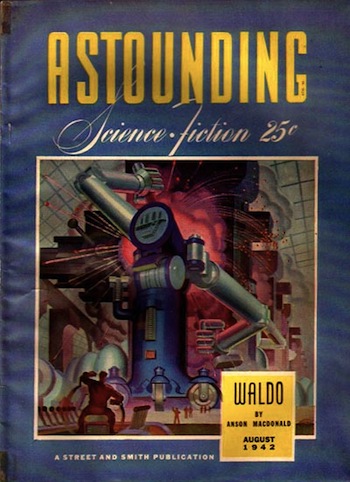Science Fiction
Dictionary
A B C D E F G H I J K L M N O P Q R S T U V W X Y Z
Fukushima Plant Needs Radiation-Proof Scorpion Robots

The robots used at the Fukushima nuclear power plant in Japan are failing due to the high levels of radiation. The meltdown was triggered during the earthquake and tsunami of 2011. It's too much even for these specially hardened scorpion bots, as seen in the following video.
(Fukushima scorpion robots radiation fail)
The radiation levels on the site are far higher than any human could possibly survive, so engineers are using purpose-built “scorpion” robots with cameras attached to survey the scale of the damage.The latest attempt to harvest data on Fukushima failed after a robot designed by Toshiba to withstand high radiation levels died five times faster than expected.
The robot was supposed to be able to cope with 73 sieverts of radiation, but the radiation level inside the reactor was recently recorded at 530 sieverts.
A single dose of one sievert is enough to cause radiation sickness and nausea; 5 sieverts would kill half those exposed to it within a month, and a single dose of 10 sieverts would prove fatal within weeks.
Radiation-proof robots have been recommended by science fiction writers ever since the dawn of the cold war. In his classic 1953 story The Defenders, Philip K. Dick describes leadies:

(From The Defenders, by Philip K. Dick)
Now the surface was a lethal desert of slag and rolling clouds. Endless clouds drifted back and forth, blotting out the red Sun. Occasionally something metallic stirred, moving through the remains of a city, threading its way across the tortured terrain of the countryside. A leady, a surface robot, immune to radiation, constructed with feverish haste in the last months before the cold war became literally hot.
(Read more about Philip K. Dick's leady)
A year earlier, science fiction fan and sometimes writer Mari Wolf describes lead-bodied androids in her 1952 story Robots of the World! Arise!:
I'd designed the androids myself, plotted out the pile locations, set up the simplified reactors. And now it was making money. For men to work in a uranium plant you need yards of shielding, triple-checking, long cooling-off periods for some of the hotter products. But with lead-bodied, radio-remote controlled androids, it's easier.
(Read more about Mari Wolf's lead-bodied androids)
As so often happens, I have to give sf Grandmaster Robert Heinlein his due and mention the waldo from his 1942 novella of the same name (using his pseudonym Anson MacDonald). The country's nascent nuclear industry liked the idea, and actually created similar devices to deal with nuclear material - they liked the name, too.

Via Independent.
Scroll down for more stories in the same category. (Story submitted 4/11/2017)
Follow this kind of news @Technovelgy.| Email | RSS | Blog It | Stumble | del.icio.us | Digg | Reddit |
Would
you like to contribute a story tip?
It's easy:
Get the URL of the story, and the related sf author, and add
it here.
Comment/Join discussion ( 0 )
Related News Stories - (" Robotics ")
Golf Ball Test Robot Wears Them Out
"The robot solemnly hit a ball against the wall, picked it up and teed it, hit it again, over and again...' - Frederik Poh, 1954.
PaXini Supersensitive Robot Fingers
'My fingers are not that sensitive...' - Ray Cummings, 1931.
Artificial Skin For Robots Is Coming Right Along
'... an elastic, tinted material that had all the feel and appearance of human flesh and epidermis.' - Harl Vincent (1934)
Robot Guard Dog On Duty
I might also be thinking of K-9 from Doctor Who.
Technovelgy (that's tech-novel-gee!) is devoted to the creative science inventions and ideas of sf authors. Look for the Invention Category that interests you, the Glossary, the Invention Timeline, or see what's New.
Science Fiction
Timeline
1600-1899
1900-1939
1940's 1950's
1960's 1970's
1980's 1990's
2000's 2010's
Current News
Golf Ball Test Robot Wears Them Out
"The robot solemnly hit a ball against the wall, picked it up and teed it, hit it again, over and again...'
Boring Company Vegas Loop Like Asimov Said
'There was a wall ahead... It was riddled with holes that were the mouths of tunnels.'
Rigid Metallic Clothing From Science Fiction To You
'...support the interior human structure against Jupiter’s pull.'
Is The Seattle Ultrasonics C-200 A Heinlein Vibroblade?
'It ain't a vibroblade. It's steel. Messy.'
Roborock Saros Z70 Is A Robot Vacuum With An Arm
'Anything larger than a BB shot it picked up and placed in a tray...'
A Beautiful Visualization Of Compact Food
'The German chemists have discovered how to supply the needed elements in compact, undiluted form...'
Bone-Building Drug Evenity Approved
'Compounds devised by the biochemists for the rapid building of bone...'
Secret Kill Switch Found In Yutong Buses
'The car faltered as the external command came to brake...'
Inmotion Electric Unicycle In Combat
'It is about the size and shape of a kitchen stool, gyro-stabilized...'
Grok Scores Best In Psychological Tests
'Try to find out how he ticks...'
PaXini Supersensitive Robot Fingers
'My fingers are not that sensitive...'
Congress Considers Automatic Emergency Braking, One Hundred Years Too Late
'The greatest problem of all was the elimination of the human element of braking together with its inevitable time lag.'
The Desert Ship Sailed In Imagination
'Across the ancient sea floor a dozen tall, blue-sailed Martian sand ships floated, like blue smoke.'
The Zapata Air Scooter Would Be Great In A Science Fiction Story
'Betty's slapdash style.'
Thermostabilized Wet Meat Product (NASA Prototype)
There are no orbiting Michelin stars. Yet.
Could Crystal Batteries Generate Power For Centuries?
'Power could be compressed thus into an inch-square cube of what looked like blue-white ice'
